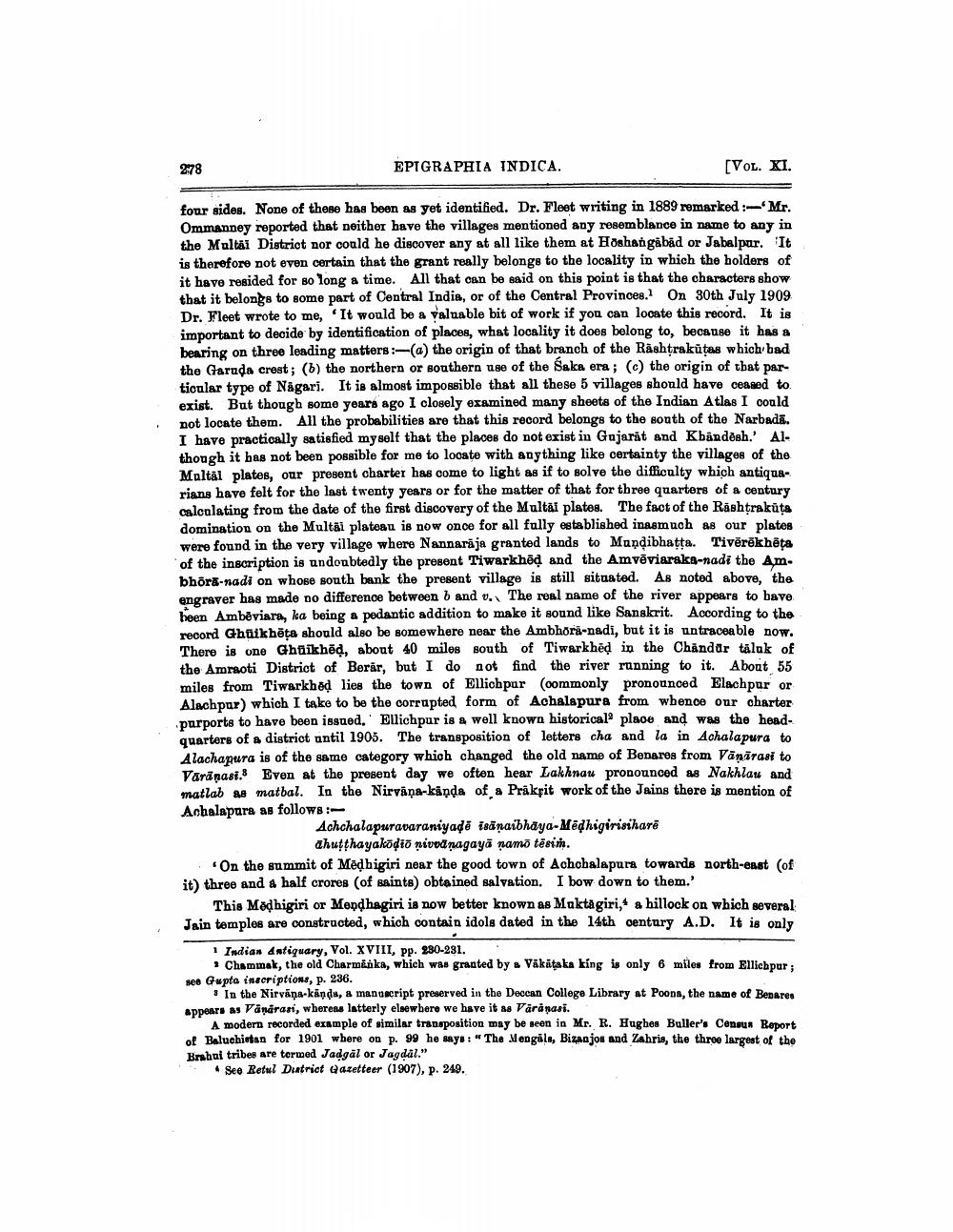________________
278
EPIGRAPHIA INDICA.
[VOL. XI.
four sides. None of these has been as yet identified. Dr. Fleet writing in 1889 remarked : Mr. Ommanney reported that neither have the villages mentioned any resemblance in name to any in the Multai District nor could he discover any at all like them at Hoshangabad or Jabalpur. It is therefore not even certain that the grant really belongs to the locality in which the holders of it havo resided for so long a time. All that can be said on this point is that the characters show that it belongs to some part of Central India, or of the Central Provinces. On 30th July 1909 Dr. Fleet wrote to me, It would be a valuable bit of work if you can locate this record. It is important to decide by identification of places, what locality it does belong to, because it has a bearing on three leading matters :-(a) the origin of that branch of the Rashtrakūtas which bad the Garuda crest; (b) the northern or southern use of the Saka era; (c) the origin of that partionlar type of Nagari. It is almost impossible that all these 5 villages should have ceased to exist. But though some years ago I closely examined many sheets of the Indian Atlas I could not locate them. All the probabilities are that this record belongs to the south of the Narbadā. I have practically satisfied myself that the places do not exist in Gujarat and Kbändesh.' Although it has not been possible for me to locate with anything like certainty the villages of the Multál plates, our present charter has come to light as if to solve the difficulty which antiquarians have felt for the last twenty years or for the matter of that for three quarters of a century calculating from the date of the first discovery of the Multai plates. The fact of the Rashtraküta domination on the Multai plateau is now once for all fully established inasmuch as our plates were found in the very village where Nannarāja granted lands to Mandibhatta. Tivērēkhēta of the inscription is undoubtedly the present Tiwarkhod and the Amvēviaraka-nadi the Am. bhora-nadi on whose south bank the present village is still situated. As noted above, the engraver has made no difference between b and 0. The real name of the river appears to have heen Ambëviara, ka being a pedantic addition to make it sound like Sanskrit. According to the record Ghaikhēta should also be somewhere near the Ambhörä-nadi, but it is untraceable now. There is one Ghiikhēd, about 40 miles south of Tiwarkhed in the Chándar täluk of the Amraoti District of Berår, but I do not find the river running to it. About 55 miles from Tiwarkhod lies the town of Ellichpur (commonly pronounced Elachpur or Alachpar) which I take to be the corrupted form of Achalapura from whence our charter purports to have been issued.' Ellichpur is a well known historical place and was the headquarters of a district until 1905. The transposition of letters cha and la in Achalapura to Alachapura is of the same category which changed the old name of Bonaros from Vānārasi to Varanasi. Even at the present day we often hear Lakhnau pronounced as Nakhlau and matlab as matbal. In the Nirvana-kända of a Prakrit work of the Jains there is mention of Achalapura as follows:
Achchalapuravaraniyadē isānaibhaya-Mēdhigirisiharē
ahutthayakodio nivodnagaya namo tēsim. On the summit of Mēdhigiri near the good town of Achchalapura towards north-east of it) three and a half crores (of saints) obtained salvation. I bow down to them.'
This Modhigiri or Mondhagiri is now better known as Muktagiri, & hillock on which several Jain temples are constructed, which contain idols dated in the 14th century A.D. It is only
1 Indian antiquary, Vol. XVIII, pp. 280-281.
· Chammak, the old Charminka, which was granted by Vakitaka king is only 6 miles from Ellichpur : seo Gupta inscriptions, p. 236.
In the Nirvana-kands, a mano cript preserved in the Deccan College Library at Poons, the name of Benares appears as Vanarasi, whereas latterly elsewhere we have it as Varanasi.
A modern recorded example of similar transposition may be seen in Mr. R. Hughes Buller's Census Report el Baluchistan for 1901 where on p. 99 he says: "The Mengals, Bizaajor and Zabris, the three largest of the Brahui tribes are termed Jadgal or Jagdal."
See Retul Dutrict Qazetteer (1907), p. 249.




